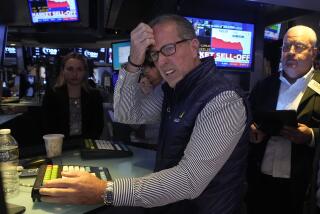Computers Sped Trades Despite Crisis Volume
- Share via
NEW YORK — Back in 1968, the average number of shares traded daily on the New York Stock Exchange was just under 13 million, a far cry from the record 608 million traded Tuesday.
Yet, on Wednesday, June 12, 1968, the New York Stock Exchange and its little sister, the American Stock Exchange--its member firms drowning in paper work--simply didn’t open for trading in order to catch up. The four-day trading week lasted the rest of that year.
Things are vastly different today. Although there were some minor delays as trading mushroomed to astounding proportions this week, no significant breakdowns or bottlenecks developed at the major exchanges or in the back offices of the major brokerage houses. A notable exception was the Pacific Stock Exchange, which was forced to close a half hour early after its computer system was unable to cope with the increased volume.
Five-Hour Shutdown
At the exchange’s headquarters in San Francisco, Chairman Maurice Mann said the PSE’s automated trading system was forced to shut down Wednesday for about five hours after operating at roughly 150% of planned capacity for the first two days of the week.
The shutdown reduced trading volumes, as brokers had to place their orders by phone or on other markets rather than over the 8-year-old computer system.
“The system is not prepared to take (such) unprecedented volumes or unprecedented volatility,” Mann said, adding that the exchange will study changes to prevent a recurrence.
Despite that problem, however, automation was cited as the main reason most exchanges did not grind to a halt in this week’s blizzard of trading.
“We have built a computer system pretty much insensitive to the heavy volumes we have seen in the past few days,” said Nicholas E. Bonadies, director of operations for Prudential-Bache Securities. “Without the computer no one (on Wall Street) could cope . . . .”
Some Wall Street back office employees and some working on the exchange floors have worked overtime this week to keep up. But the situation doesn’t compare to the round-the-clock and weekend work needed to stay on top in the mid-1960s, observers say.
James Squyres, vice president of Securities Industry Automation Corp., a subsidiary of the New York and American exchanges which operates data-processing and computer operations for the two exchanges and the industry, says the high volume of recent days really tested the system. “The securities industry is doing something that nobody thought was possible. It is breathing hard; but although there are a few problems, a miracle is occurring every single day.”
The electronic “tape” which reports transactions fell far behind the trading pace on Monday and Tuesday--at one point by more than 90 minutes. But that doesn’t mean that trading was delayed, Squyres said.
The familiar tape on display at brokerages across the country is purposely kept moving at a pace that can be read, he said. The actual tape is recording transactions as they occur and thus moves much faster. The tape delay is only a convenience for investors, he said, and doesn’t reflect an inability to record transactions. But it does mean that investors may not have up-to-the-minute information.
The market also was able to take the record trading in stride because brokerage houses had prepared themselves.
Giant Merrill Lynch, for example, began to test its capacity as long ago as 1981, according to Vincent Grillo, a data center strategist for the firm. The firm has run regular drills with its employees to see how well they can handle high-volume trading.
“We had not yet tested for a 600-million-share day,” Grillo said. “But we were surely tested on Monday and Tuesday.”
Before Wall Street was automated, the process was much more cumbersome. When a trade was ordered in Los Angeles, it had to be transmitted to the brokerage’s home office, then to the trading floor where a floor broker carried it to a specialist’s post. After the trade was made, the process was repeated in reverse. Today, a branch office communicates directly with the specialists on the floor.
Cumbersome Process
The computer isn’t the only reason the securities business kept up with the heavy volume. Today’s trading is much more concentrated in large transactions. Large institutional investors such as pension funds dominate the current market. In 1965, trades of 10,000 shares or more accounted for just 3.1% of total volume. That has risen to a 51.3% this year. That means the number of transactions, while sharply higher, has not risen as much as total volume.
Ironically, the advent of the computer on Wall Street has virtually eliminated the paper that caused the backups in the trading process. Even the scraps that cascade down New York’s concrete canyons during ticker-tape parades, which used to come from Wall Street’s back offices, now are imported from New Jersey.
And stock certificates, which small investors used to squirrel away in safe deposit boxes, are hardly seen any more.
“The number of people who ask for certificates is insignificant, and it is a nuisance,” Squyres said. “Today, there is one giant stock certificate (for each company). It is known in the industry as the jumbo. It is held in vaults under Wall Street by Depository Trust Co.”
Staff writer Dan Morain in San Francisco contributed to this article.
More to Read
Inside the business of entertainment
The Wide Shot brings you news, analysis and insights on everything from streaming wars to production — and what it all means for the future.
You may occasionally receive promotional content from the Los Angeles Times.










